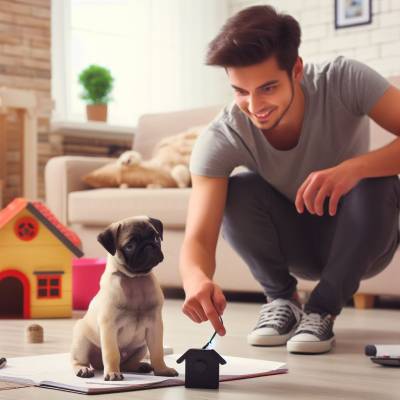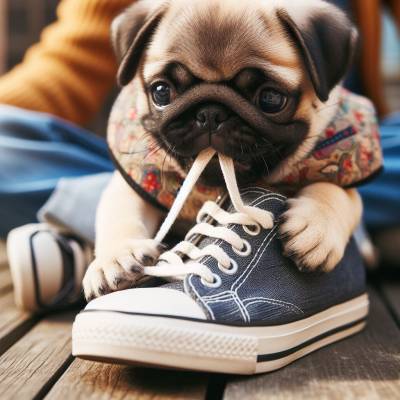Patience, Pups, and Potties: The Ultimate Handbook on How Long It Takes to House Train Your Furry Friend

Housebreaking a new puppy is often a top concern for many pet owners. With varying advice and methods available, it’s essential to understand the typical timeline and factors influencing a pup’s potty training journey. This article sheds light on the subject, providing clarity and effective strategies for a smoother transition into pet parenthood.
I. Introduction
Housebreaking a puppy is one of the fundamental steps in integrating a new canine member into a household. While it’s a challenge every dog owner must face, the process can be filled with both rewarding milestones and occasional setbacks.
A. Importance of housebreaking
Training a puppy to do its business at the right place and time is vital for maintaining a clean and healthy living environment. It not only spares your home from unpleasant surprises but also establishes a routine, helping to foster a bond of trust and understanding between owner and pet.
B. Variability in training timelines
It’s essential to recognize that house training does not follow a one-size-fits-all timeline. Various factors come into play, affecting how quickly a puppy can be fully house-trained. It’s a journey of patience, consistency, and understanding.
II. Factors Influencing House Training Duration
Every puppy is unique, and while some might pick up potty habits quickly, others could take a bit longer.
A. Puppy’s age and breed
Younger puppies, typically under 12 weeks, don’t have full bladder control, making them more prone to accidents. Additionally, certain breeds are notoriously harder to train, while others might catch on faster due to their inherent nature.
B. Consistency in training
The more consistent you are with your training schedule and methods, the faster the puppy will learn. Regularly taking them out after meals, playtime, or naps can drastically reduce the time it takes to house train.
C. Individual puppy temperament
Some puppies are naturally more eager to please, while others can be more stubborn. Understanding and adapting to your puppy’s temperament can influence the duration of training.
III. Effective House Training Techniques
Achieving house training success revolves around utilizing proven techniques tailored to your puppy’s needs.
A. Crate training benefits
Using a crate can help in teaching puppies to control their bladder and bowel movements, as they typically don’t like soiling their sleeping areas.
B. Setting a routine
Consistency is key. Establishing a fixed schedule for meals, playtime, and potty breaks can make the house training process smoother.
C. Positive reinforcement and its role
Rewarding your puppy for doing the right thing can go a long way. Treats, praises, or playtime can motivate them to follow the potty routine.
D. Recognizing and responding to signs
Puppies often exhibit signs like circling, sniffing, or whining when they need to go. Recognizing these signs and acting promptly can prevent accidents and reinforce training.
IV. Common House Training Mistakes
Even seasoned dog owners can make mistakes. Being aware of these can help in avoiding them.
A. Inconsistent schedules
Irregular feeding or potty break schedules can confuse a puppy, prolonging the training process.
B. Negative reinforcement pitfalls
Scolding or punishing a puppy post-accident is counterproductive. It can lead to fear and mistrust, making them hide when they need to go.
C. Overlooking medical issues
Sometimes, frequent accidents can be a sign of underlying medical issues. It’s essential to rule out any health concerns if house training seems unusually challenging.
V. How to Ensure Continued Success
After the initial house training phase, it’s crucial to ensure that good habits remain ingrained.
A. Transitioning to unsupervised times
As trust builds, allowing your puppy more freedom while monitoring for any regression is vital.
B. Addressing accidents effectively
Accidents will happen. Instead of punishment, clean up thoroughly to remove scent markers and maintain consistency in training.
C. Maintenance routines for mature dogs
As dogs age, their routines might change. Keeping an eye on their habits and adjusting schedules accordingly ensures continued house training success.
VI. FAQs
Q: Can an 8-week-old puppy be potty trained?
A: At 8 weeks, puppies are still very young and lack full bladder control. While they can begin the house training process, it’s unlikely they’ll be fully potty trained at this age.
Q: Can you house-train a puppy in 2 weeks?
A: While some puppies might grasp the basics in 2 weeks, complete house training usually takes longer. Consistency, patience, and the individual puppy’s temperament all play roles in the duration.
Q: What is the best and quickest way to house-train a puppy?
A: The quickest way is through consistency, establishing a routine, using positive reinforcements, and addressing accidents promptly without punishment.
Q: What dog breeds are hardest to potty train?
A: Breeds like Dachshunds, Bichon Frises, and Afghan Hounds are sometimes noted as being more challenging to potty train due to their stubborn or independent nature.
Q: How often should I take my puppy out during the night?
A: Puppies under 12 weeks may require 1-2 nighttime bathroom breaks. As they grow, they can usually hold it longer, reducing the need for nighttime outings.
Q: Does using puppy pads delay house training?
A: Puppy pads can be useful for apartment dwellers or during bad weather, but relying on them too much can make sure a puppy understands where it’s acceptable to relieve themselves.
Q: Are some puppies naturally easier to house-train?
A: Yes, some puppies, due to their breed or individual temperament, may pick up on house training more readily than others.
VII. Conclusion
A. Reiteration of key takeaways
House training is a multifaceted endeavor that requires patience, consistency, and understanding of your puppy’s unique needs and behaviors.
B. Encouragement for patient and consistent training
Every puppy is distinct, and while house training might pose challenges, the bond it helps build between owner and pet is well worth the effort.
VIII. Suggested Readings
For those eager to delve deeper into the world of dog training and understanding, here are some insightful reads:
- “The Art of Raising a Puppy” by Monks of New Skete – A comprehensive guide to understanding puppy behavior and successful training techniques.
- “How to Housebreak Your Dog in 7 Days” by Shirlee Kalstone – A focused approach to house training with a week-long plan.
- “Puppy Training for Kids” by Colleen Pelar – An excellent resource for families, teaching children the basics of raising and training a new puppy.
- “The Puppy Primer” by Patricia B. McConnell and Brenda Scidmore – A straightforward guide packed with exercises and advice for new puppy owners.
- “Before and After Getting Your Puppy” by Dr. Ian Dunbar – A detailed guide that covers everything from choosing the right puppy to setting the foundation for good habits early on.






